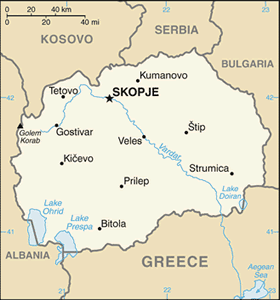The Geography of Macedonia
The Geography of Macedonia
Macedonian Geography
Location: Southeastern Europe, north of Greece
Geographic coordinates: 41 50 N, 22 00 E
Map references: Europe
Area: total: 25,333 sq km land: 24,856 sq km water: 477 sq km
Area - comparative: slightly larger than Vermont
Land boundaries: total: 766 km border countries: Albania 151 km, Bulgaria 148 km, Greece 246 km, Kosovo 159 km, Serbia 62 km
Coastline: 0 km (landlocked)
Maritime claims: none (landlocked)
Climate: warm, dry summers and autumns; relatively cold winters with heavy snowfall
Terrain: mountainous territory covered with deep basins and valleys; three large lakes, each divided by a frontier line; country bisected by the Vardar River
Elevation extremes: lowest point: Vardar River 50 m highest point: Golem Korab (Maja e Korabit) 2,764 m
Natural resources: low-grade iron ore, copper, lead, zinc, chromite, manganese, nickel, tungsten, gold, silver, asbestos, gypsum, timber, arable land
Land use: arable land: 22.01% permanent crops: 1.79% other: 76.2% (2005)
Irrigated land: 550 sq km (2003)
Natural hazards: high seismic risks
Environment - current issues: air pollution from metallurgical plants
Environment - international agreements: party to: Air Pollution, Biodiversity, Climate Change, Climate Change-Kyoto Protocol, Desertification, Endangered Species, Hazardous Wastes, Law of the Sea, Ozone Layer Protection, Wetlands signed, but not ratified: none of the selected agreements
Geography - note: landlocked; major transportation corridor from Western and Central Europe to Aegean Sea and Southern Europe to Western Europe


